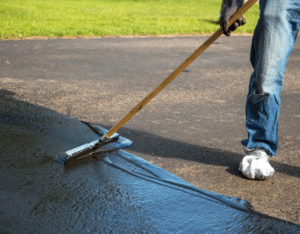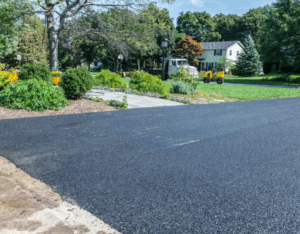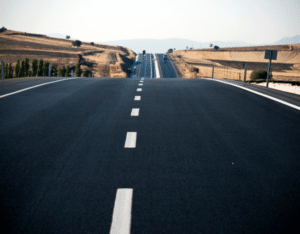Introduction
Pavement maintenance plays a crucial role in ensuring the longevity and durability of roadways and driveways. Over time, environmental factors, traffic volume, and regular wear and tear can deteriorate the quality of pavement surfaces, leading to costly repairs or replacement. Therefore, it is essential for property owners and municipal planners to be aware of the various maintenance options available.
Two commonly used methods for pavement maintenance are slurry seal and asphalt overlay. Slurry seal involves the application of a thin layer of slurry mixture that rejuvenates the existing surface, seals cracks, and provides a smooth and durable driving experience. On the other hand, asphalt overlay is a more extensive process that involves the application of a new layer of asphalt on top of the existing pavement, offering enhanced structural strength and durability.
Understanding the differences between slurry seal and asphalt overlay is vital for making informed decisions about which method best suits specific maintenance needs and long-term performance goals. By comparing their characteristics, benefits, and limitations, property owners and municipal planners can ensure the most cost-effective and suitable solution for preserving and extending the life of their roadways and driveways.

Understanding Slurry Seal
Slurry seal is a protective coating applied to asphalt surfaces to extend their lifespan and enhance their performance. It is composed of a mixture of aggregate, asphalt emulsion, and fillers. The application process involves spreading the slurry seal mixture over the existing asphalt pavement using specialized equipment.
One of the key advantages of slurry seal is its cost efficiency. It is a more affordable option compared to other pavement maintenance techniques such as asphalt overlays. Slurry seal also requires shorter curing times, allowing the surface to be reopened to traffic sooner than other methods. Additionally, slurry seal is known for its environmental friendliness as it can be made with recycled materials and reduces the need for new asphalt production. Slurry seal is best used in low traffic areas or as a preventive maintenance measure. It is ideal for parking lots, residential streets, and other surfaces that experience minimal wear and tear. By applying slurry seal, property owners and municipal planners can protect their asphalt surfaces from oxidation, weathering, and minor surface damages, ultimately helping to extend the life of the pavement.
Slurry seal is a cost-effective, environmentally friendly solution for maintaining and protecting asphalt surfaces. It offers advantages such as shorter curing times and is best suited for low traffic areas or as preventive maintenance. By understanding the benefits and best uses of slurry seal, property owners and municipal planners can make informed decisions to meet their specific maintenance needs and long-term performance goals.
Understanding Asphalt Overlay
Asphalt overlay refers to a process where a new layer of asphalt is applied over the existing pavement surface. This technique is commonly used to restore and enhance the functionality of aged or deteriorating pavements. The process involves cleaning the existing pavement, repairing any structural issues, and then applying a new layer of asphalt to create a smooth and durable surface.
One of the main advantages of asphalt overlay is its ability to handle larger structural issues. It provides a cost-effective solution for pavements with cracks, potholes, and other significant surface damage. By covering the existing pavement with a new layer of asphalt, the overlay can strengthen the structure and improve its load-bearing capacity. Durability is another key advantage of asphalt overlay. The new layer of asphalt acts as a protective barrier against traffic loads, weathering, and other environmental factors. It helps to prolong the lifespan of the pavement and reduce the need for frequent repairs and maintenance.
Asphalt overlay is best suited for high-traffic areas or places that have experienced significant surface damage. It provides a long-lasting solution that improves the overall safety and functionality of the pavement. By understanding the benefits and best uses of asphalt overlay, property owners and municipal planners can make informed decisions for their specific maintenance needs and long-term performance goals.
Comparative Analysis: Performance Factors
- Longevity
Longevity is a crucial factor to consider when selecting a pavement maintenance treatment for property owners and municipal planners. Comparing the lifespan of slurry seal and asphalt overlay under different traffic conditions and environmental factors can provide valuable insights. Under moderate traffic conditions and favorable environmental factors such as mild climate and minimal exposure to heavy vehicles, slurry seal typically lasts around 5-8 years. This treatment involves applying a mixture of water, emulsified asphalt, and aggregate to the existing pavement surface, providing a protective layer that enhances skid resistance and sealing against moisture intrusion.
In contrast, asphalt overlay offers a longer lifespan. Generally, an asphalt overlay can last 10-15 years under similar traffic conditions and environmental factors. This treatment involves placing a new layer of hot mix asphalt over the existing pavement, improving structural integrity and aesthetic appearance. However, it’s important to note that the actual longevity of both treatments is influenced by several factors, including traffic volume and weight, climatic conditions (such as freezing and thawing cycles), and maintenance practices. Regular inspections and proactive maintenance can help extend the lifespan of both slurry seal and asphalt overlay.
Ultimately, when deciding between slurry seal and asphalt overlay, property owners and municipal planners should consider their specific maintenance needs and long-term performance goals. While slurry seal may be more cost-effective and suitable for low-traffic areas, asphalt overlay offers greater durability and longevity for high-traffic locations.
- Cost
The cost comparison between slurry seal and asphalt overlay involves analyzing the initial costs versus the long-term investment for both methods. While slurry seal is generally less expensive initially compared to asphalt overlay, it often requires more frequent maintenance. This can result in higher long-term costs. Slurry seal typically needs to be reapplied every 5-7 years, while an asphalt overlay can last up to 10-15 years before requiring major maintenance. Additionally, slurry seal typically has a shorter life extension compared to asphalt overlay. While asphalt overlay can extend the life of the pavement by 10-15 years, slurry seal typically provides a life extension of 3-5 years. Considering these factors, property owners and municipal planners need to carefully assess their maintenance needs and long-term performance goals. If cost savings in the short term are a priority, slurry seal may be a suitable option. However, if the aim is to reduce long-term costs and minimize the frequency of maintenance, an asphalt overlay may be a better choice.
Ultimately, the decision between slurry seal and asphalt overlay hinges on the specific requirements and budget constraints of the property owner or municipal planner. By weighing the initial costs with long-term investment considerations, an informed decision can be made regarding which method is most suitable for their maintenance needs and long-term performance goals.
- Effectiveness in Weather Resistance
Slurry seal and asphalt overlay are both pavement maintenance methods that aim to improve the longevity and durability of roads. When it comes to weather resistance, both methods have their strengths and weaknesses.
In terms of rain resistance, slurry seal is known to be highly effective. The slurry seal mixture is designed to create a waterproof barrier on the pavement surface, preventing water from infiltrating and causing damage. It is particularly suitable for areas that experience heavy rainfall and frequent precipitation events. Heat can pose challenges to any pavement maintenance method, but asphalt overlay tends to have better resistance to high temperatures. Asphalt is known for its ability to expand and contract with temperature changes, allowing it to withstand the heat without significant damage. On the other hand, slurry seal can soften and become more susceptible to wear and tear under extreme heat conditions. Freeze-thaw cycles can wreak havoc on pavements, causing cracks and potholes. In this aspect, both slurry seal and asphalt overlay have similar performance. Both methods can provide adequate protection against freeze-thaw damage, as long as the pavements are properly constructed and maintained.
Both slurry seal and asphalt overlay have their advantages and limitations when it comes to weather resistance. Slurry seal excels in rain resistance, while asphalt overlay is more resilient to high temperatures. However, both methods can effectively combat freeze-thaw cycles with proper installation and maintenance practices. Decisions regarding which method to choose should be based on the specific weather challenges of the area as well as the long-term performance goals of the property owners or municipal planners.
- Installation Time and Traffic Disruption
When it comes to installation time, slurry seal and asphalt overlay differ significantly. Slurry seal is a quick and relatively straightforward process. It involves applying a mixture of asphalt emulsion, aggregate, water, and additives to the existing pavement surface. The application can typically be completed within a day or two, depending on the size of the project. Once the slurry seal has dried and cured, which usually takes a few hours to a day, traffic can be resumed. This minimal downtime allows property owners and municipal planners to minimize disruptions to daily operations in the area. On the other hand, asphalt overlay requires more time for installation. It involves placing a new layer of hot mix asphalt over the existing pavement. The process typically takes longer compared to slurry seal due to the need for proper preparation, including removing any existing deteriorated pavement and ensuring a smooth and stable base. Depending on the extent of the project, installation can take several days or even weeks. After the asphalt overlay is laid, it needs time to cool and cure before traffic can be allowed back on the road. This curing process can take anywhere from a day to a week.
Considering the differences in installation time, slurry seal emerges as the more efficient option when it comes to minimizing traffic disruption and reducing the impact on daily operations in the area.
Maintenance and Care
Slurry seal and asphalt overlay are both effective methods for preserving and maintaining pavement surfaces. However, they each have unique maintenance requirements that property owners and municipal planners should be aware of. For slurry seal, ongoing maintenance needs are relatively minimal. Regular sweeping and street cleaning is recommended to remove debris and prevent the accumulation of dirt and other particles. In addition, it is important to periodically inspect the slurry-sealed surface for any signs of damage or wear, and address any issues promptly to prevent further deterioration. Asphalt overlay, on the other hand, requires more regular maintenance to ensure its longevity. Crack sealing and filling should be done as soon as cracks appear, as these can lead to more serious issues if left untreated. Additionally, routine sealcoating is advised to protect the overlay from the harmful effects of UV rays, water penetration, and other environmental factors.
To extend the pavement life of both slurry-sealed and overlaid surfaces, it is essential to follow some best practices. First and foremost, proper drainage is crucial to prevent the accumulation of water on the pavement, as this can lead to cracking and other structural damage. Regular cleaning and sweeping should be done to remove debris and prevent surface deterioration. Implementing a regular inspection and maintenance schedule is also recommended to identify and address any issues in a timely manner.
By understanding the maintenance needs of slurry seal and asphalt overlay, property owners and municipal planners can make informed decisions and ensure the longevity of their pavement surfaces. Following these maintenance and care tips will help extend the life of the pavement and minimize the need for costly repairs or replacements.
Conclusion
Choosing between slurry seal and asphalt overlay depends on specific needs and conditions. Slurry seal is a cost-effective option for maintaining a pavement surface, providing protection against weathering, aging, and minor distresses. It is suitable for low-traffic roads and parking lots with minimal cracking and surface wear. On the other hand, asphalt overlay offers a more extensive repair solution for surfaces with moderate to severe damage, such as deep cracks, potholes, and rutting. It provides a durable and long-lasting pavement surface capable of withstanding heavy traffic loads. Property owners and municipal planners should consult with paving professionals to assess their unique situation and determine the most appropriate method. Professionals can evaluate the pavement condition, traffic volume, and budget constraints to make an informed decision. By considering these factors, property owners and municipal planners can select the right maintenance option and set their long-term performance goals for their pavement surface.



